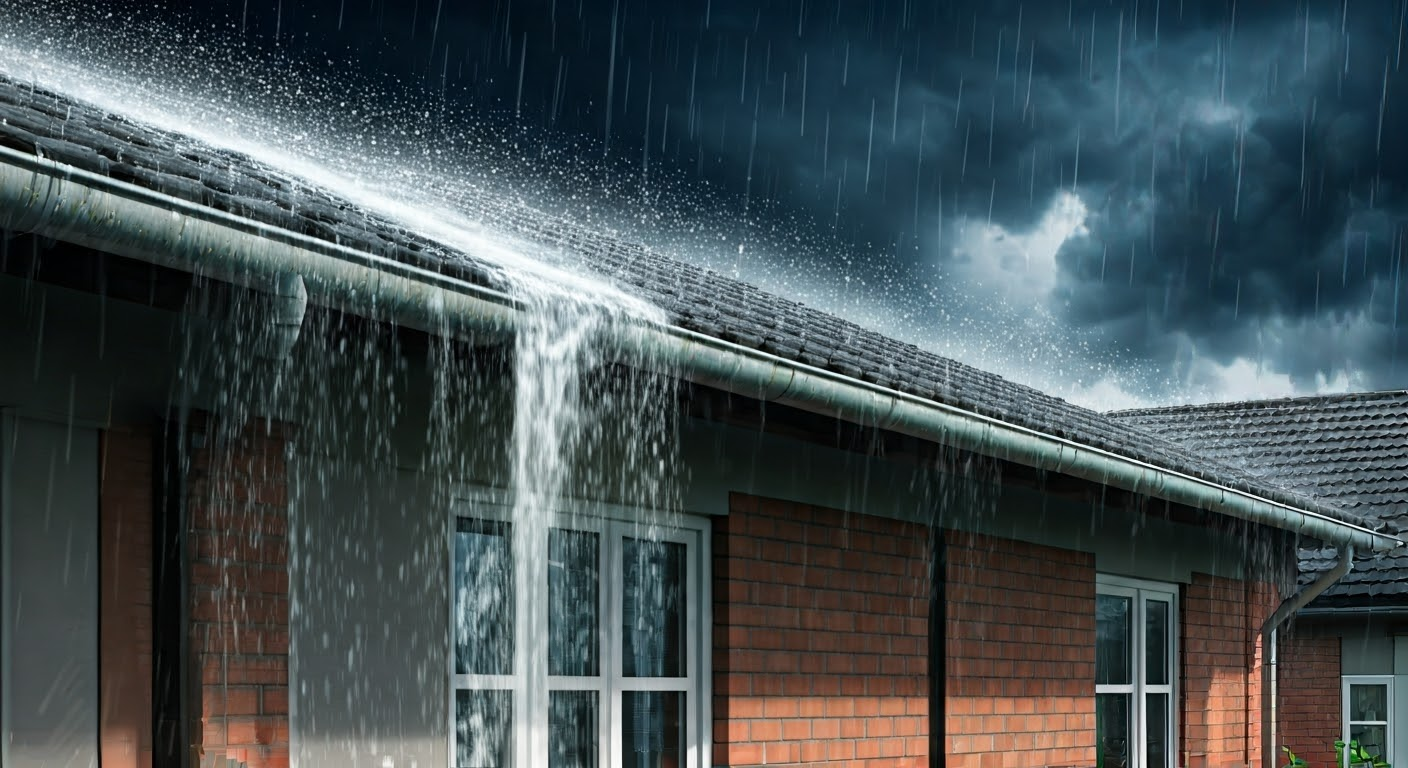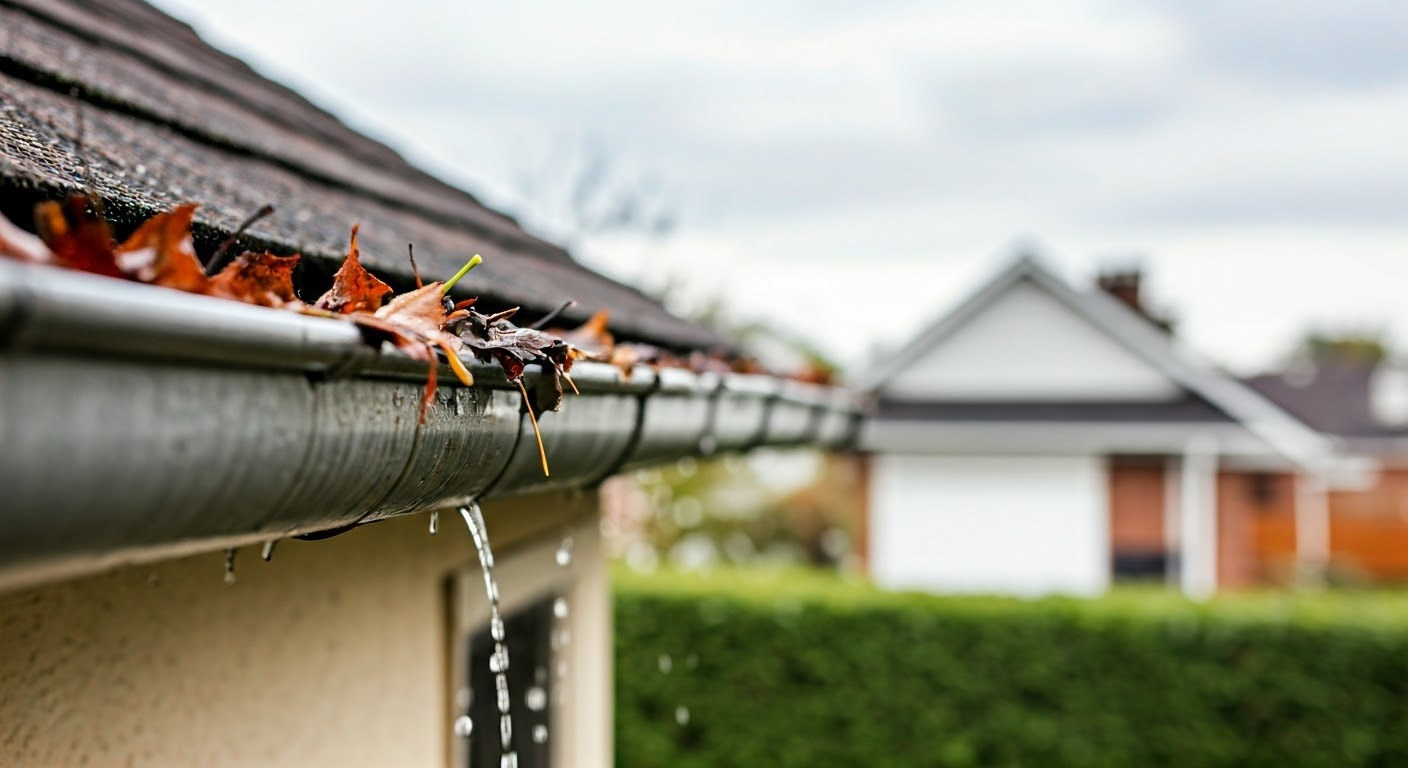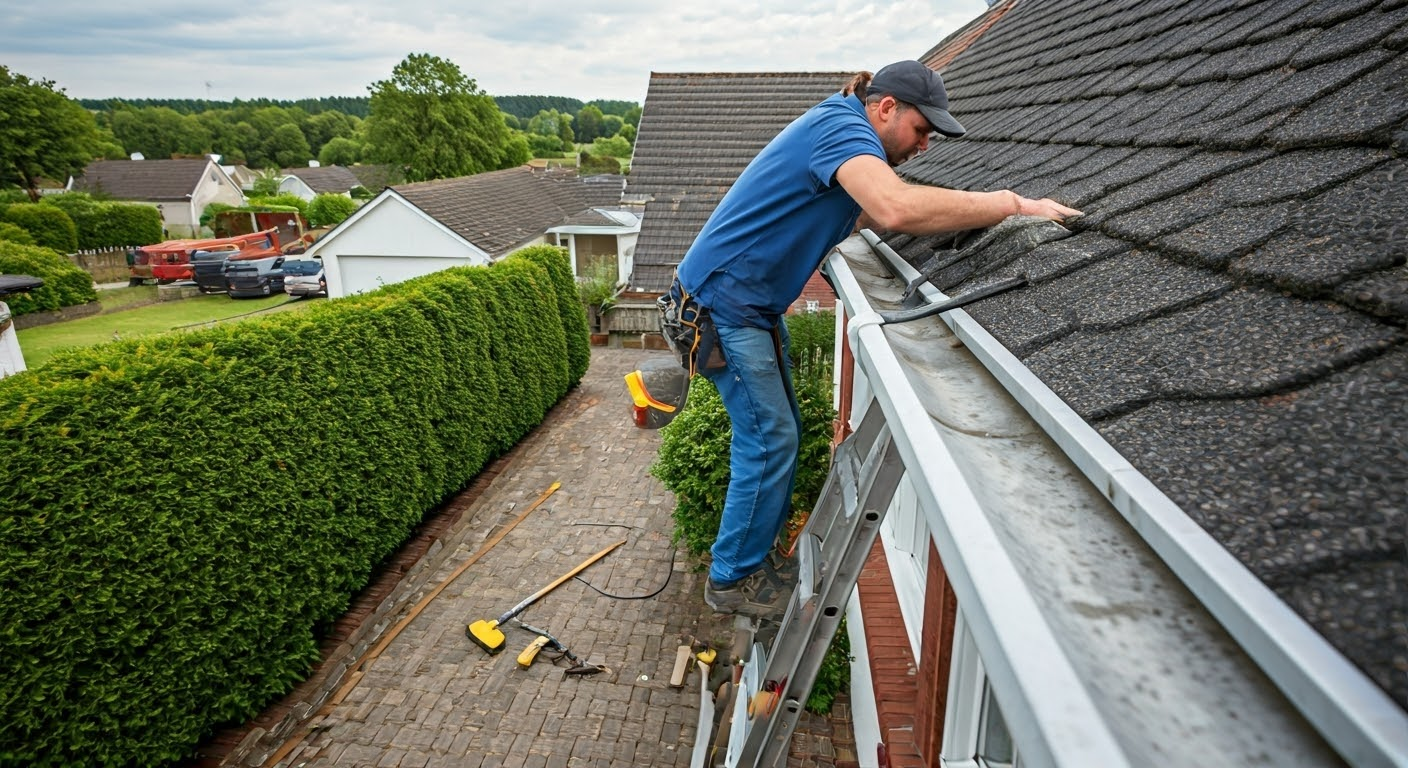Rain Gutter Overflow 5 Common Rain Gutters Overflowing Problems

Key Highlights of Rain Gutter Overflow.
- Rain gutter overflow can cause significant water damage to a home’s foundation, siding, roofing, and landscaping.
- Clogged gutters, incorrect installation, inadequate size, insufficient downspouts, and damaged gutters are common causes of gutter overflow.
- Heavy rain and overflowing gutters can lead to erosion, rot, and mould growth, compromising your home’s structural integrity.
- Simple fixes, like cleaning gutters and adjusting their pitch, can often resolve the issue effectively.
- Regular maintenance, proper installation, and using gutter guards can help prevent long-term problems.
Introduction
Your gutter system is very important for keeping your home safe from water damage and protecting your foundation. When gutters overflow, they do not direct rainwater correctly. This can cause problems like erosion, rotting, and damaged landscaping. People usually ignore overflowing gutters until the damage is apparent, but spotting the issues early can help avoid expensive repairs. This article will examine why gutter overflow happens and what you can do to keep them working well.
Professional Rain Gutter & Roof Replacement Services in Ottawa
Looking for expert rain gutter repairs or installations in Ottawa and surrounding neighbourhoods? Call or text Precision Roofing Canada at (613) 404-7805—we’re here to help!
Tevis and his team bring years of hands-on experience, a deep knowledge of roofing systems, and a commitment to quality that shines through on every job. We don’t just fix roofs—we build trust. Our work is backed by reliable communication and top-tier craftsmanship, ensuring that your gutter or roof vent project is done right the first time.
Whether you’re dealing with a sudden leak, storm damage, or just general wear and tear, you can count on Precision Roofing to respond quickly and get the job done with care and professionalism. We also provide 24/7 emergency roofing services, because your peace of mind matters.
- Rain Gutter Installation & Repairs
- Roof Vent Replacement & Repair
- Trusted local company with years of experience
Visit our trusted local listing on Google: Precision Roofing Canada – Google Business Profile
Precision-Roofing.ca is your local source for dependable service in Ottawa and beyond.
5 Common Causes of Rain Gutter Overflow
 Have you seen water spilling from the sides of your gutters during heavy rain? This problem is not just annoying; it can cause serious damage to your home. When rain gutters overflow during heavy rain, it usually indicates issues such as blockages, problems with the structure, or too small gutters. Each of these issues stops your gutter system from moving rainwater correctly. Water flowing out incorrectly can harm your landscaping, siding, and home’s foundation. Let’s look at the five main causes of gutter overflow and how to fix them.
Have you seen water spilling from the sides of your gutters during heavy rain? This problem is not just annoying; it can cause serious damage to your home. When rain gutters overflow during heavy rain, it usually indicates issues such as blockages, problems with the structure, or too small gutters. Each of these issues stops your gutter system from moving rainwater correctly. Water flowing out incorrectly can harm your landscaping, siding, and home’s foundation. Let’s look at the five main causes of gutter overflow and how to fix them.
1. Clogged Gutters
Blocked gutters are the leading cause of rain gutter overflowing. Leaves, twigs, and debris can build up and stop water from flowing properly. A clog can cause water to back up and spill over the sides even if it rains hard. Regular gutter cleaning is the first step to solving this problem.
To safely reach clogged areas, consider using tools like leaf blowers or telescopic poles instead of climbing a ladder. Don’t forget to check the downspout, too; it is very important for water flow. If there is a serious blockage, it’s best to take apart the downspout and remove the clog before putting it back together.
Cleaning your gutters every season, especially in fall and spring, ensures rainwater can leave your gutter system without overflowing. Good maintenance is key to keeping your home’s structure safe.
2. Incorrect Gutter Installation
Improper gutter installation is a common reason why gutters overflow. If the gutters are not angled correctly to direct water toward the downspouts, rainwater can get stuck. This standing water can cause sagging and structural damage over time due to the extra weight.
It’s essential to have the correct pitch. A good guideline is to keep a slant of ⅛ inch to ¼ inch for every 10 feet of gutter. If the slope goes the wrong way or is flat, water cannot flow right, leading to overflow.
Hiring professionals for gutter installation is a smart idea to avoid problems. They can ensure everything is done correctly. If your gutters are not installed well, fixing the tilt can solve the problem. A small mistake in installation can cause ongoing damage, so it’s better to do it correctly the first time.
3. Rain gutter overflow: Inadequate Gutter Size
Using too narrow gutters for your home can cause rain gutter overflow. This is especially true in areas with a lot of rainfall. The feet of the gutter around your home should match the amount of rainwater in your area. If they don’t, water will spill over the edges during storms.
Check if your current gutters are the right size for heavy rain. Houses in wet areas usually need wider gutters to manage bursts of water. Adding a larger downspout can help control water flow during strong weather.
If your gutters overflow even when clean and at the right angle, they might be too small. Upgrading to wider or seamless gutters can improve drainage and make your home look better. Choosing the right gutter size is important to stop water spillage and overflow issues.
4. Insufficient Downspouts
A downspout helps carry rainwater away from your gutters. If you have too few or too small downspouts, this can cause issues, which may upset your entire gutter system. If water doesn’t flow properly, rainwater can build up and overflow during storms.
Check how many downspouts you have and where they are placed. Bigger buildings or homes in places with a lot of rain usually need several downspouts spread out. This helps manage the amount of rainwater. It’s important to look for blockages that could affect water flow.
You can fix this by adding more downspouts. This will improve efficiency. New downspout designs can blend in with your home’s look. Remember, how well your downspouts work affects your home’s foundation, especially during heavy rain. By improving downspouts, your gutters will work well. They will keep rainwater away from your home’s foundation.
5. Damaged Gutters
Cracked, rusty, or bent gutters can cause major overflow problems. When gutters are damaged, they can’t hold or move rainwater, which can lead to leaks and spills. These signs mean the gutters are no longer strong and need immediate care.
Check your gutter system often for cracks and rust. Small leaks can be fixed, but if the damage is more serious, you might need new gutters or to replace parts. If you find yourself repairing the gutters frequently, it may be time for an upgrade.
Installing seamless gutters can help manage rainwater better and give your home a fresh look. Ignoring gutter damage can worsen and cause more issues, like erosion of your foundation. Fixing or replacing gutters should be a priority to ensure they work well and keep your home safe.
How to Fix Rain Gutter that Overflow
 To solve the problem of gutters overflowing during heavy rain, you must first identify what is wrong. The first step is to remove debris regularly. This keeps the water flowing smoothly. If cleaning the gutters doesn’t fix the issue, you should check their angle and fix it if needed.
To solve the problem of gutters overflowing during heavy rain, you must first identify what is wrong. The first step is to remove debris regularly. This keeps the water flowing smoothly. If cleaning the gutters doesn’t fix the issue, you should check their angle and fix it if needed.
If problems continue, consider replacing old or narrow gutters with wider or seamless ones. It may be best to get help from a professional for complicated installations. This way, you can keep your gutters working well and protect your home from water damage.
Maintenance Tips to Stop Rain Gutters from Overflowing
Preventing gutter overflow takes regular care, but the good news is that most tips are simple and easy to follow. Here are some helpful strategies:
- Seasonal Gutter Cleaning: Clean your gutters after the leaves fall and before spring rains. This stops blockages.
- Gutter Guards: Put these up to keep debris out and let water flow during storms.
- Ensure Downspout Efficiency: Check for clogs that can stop rainwater from flowing.
- Avoid Ice Dams: Stop slumping gutters by dealing with ice buildup quickly.
- Professional Inspection: Get an annual inspection to find hidden problems.
Keeping your gutters clean helps protect your property and saves you money on repairs. Your work now pays off when heavy rain comes without overflow issues.
Incorrect Pitch or Tilt
A problem with the tilt of your gutters can cause water overflow. The pitch helps direct rainwater into downspouts. If the slope is too flat, water may pool. If it’s too steep, it can splash and drain poorly.
You can check your gutter pitch using a level. Make sure there is a slope of ⅛ to ¼ inches for every 10 feet. If adjustments are needed, you might need to rehang the gutters or get professional help. A wrong angle can lead to sagging or even a collapse.
Fixing the pitch means finding the right balance for drainage and safety, and regular checks can spot any tilt problems early. This helps ensure that water flows correctly through your gutter system, protecting your foundation and landscaping from damage caused by overflowing gutters.
Conclusion
In summary, it is important to know the common reasons for gutters overflowing in heavy rain. Blocked gutters, bad installation, wrong size, insufficient downspouts, and damage can all cause overflow. This can lead to severe water damage to your home. By spotting these problems and keeping up with regular maintenance, you can help your gutters work well. This protects your house during heavy rainfall. Remember that taking care of your gutters prevents overflow and makes them last longer. If you have overflowing gutters, getting professional help to protect your home is a good idea.
Frequently Asked Questions about Rain Gutter Overflow
How do I prevent my gutter from overflowing in heavy rain?
Clean gutters regularly to prevent them from overflowing in heavy rain. Installing gutter guards can also help. If your roof is steep, splash guards will be beneficial. Make sure to check downspouts for clogs and clear them out. This will help water flow smoothly during storms.
What are the signs that my gutters are likely to overflow?
Look for water collecting near your foundation, stains on the siding, and drooping gutters. Also, check for plants growing too close or any visible mold. Mildew and erosion in your landscaping can show that your gutter system is not working correctly and may spill over.
Can gutter guards prevent overflowing?
Gutter guards help prevent clogs caused by leaves, twigs, and other debris. They work well, but it’s still important to clean them sometimes. Using a leaf blower can help remove debris. This way, water flow stays clear, and overflow problems can be avoided.
What should I do if my gutters overflow during a storm?
In an emergency, you can quickly fix things by using a hose to clear any visible debris. You should also check for ice dams. It’s essential to make sure downspouts are not blocked. This helps rainwater flow easily and reduces overflow during heavy rain.
Call or text Precision Roofing Canada! (613) 404-7805
Facebook | Google Business Page | YouTube | Contact Us | Blogger |